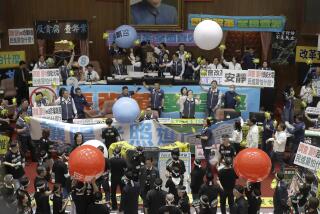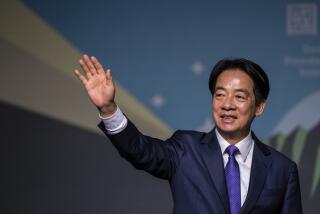Taiwan Ends Martial Law but Retains Some Limits on Rights
- Share via
TAIPEI, Taiwan — The Nationalist government of Taiwan ended 38 years of martial law Tuesday, calling the move “a new milestone” for democracy.
However, dissidents noted that a new security law immediately replaced martial law and still restricts political activity.
The Defense Ministry also announced the release of 23 prisoners, including some political dissidents jailed under martial law, and said only 30 dissidents remain jailed. The sentences of the 30 prisoners were cut in half.
Lifting of martial law means that opposition political parties can be formed legally for the first time, giving Taiwan’s fragmented but increasingly vocal opposition an opportunity to organize. The parties are required to be anti-communist and to support reunification of Taiwan with mainland China.
“We are looking at the government’s next move cautiously,” said opposition lawmaker Kang Ning-hsiang. “The political environment is still largely unclear now.”
Martial law was imposed in 1949 when Chiang Kai-shek, president of the Chinese Nationalist government, and his supporters fled the advancing Communist army on the mainland. It officially ended at the order of the late Chiang’s son, President Chiang Ching-kuo, 77.
Many observers believe that the president acted in response to the pressure of the growing dissident movement and in hopes of solidifying public support for his ruling Kuomintang (Nationalist Party) before he retires.
Martial law banned formation of any new political parties, gave the military wide censorship powers and was used to convict thousands of civilians of sedition.
Enforcement was relaxed in recent years, however.
Opposition leaders note that the Nationalists are still ensured a huge majority in national legislative bodies because most seats are reserved for delegates elected on the mainland before 1949.
More to Read
Sign up for Essential California
The most important California stories and recommendations in your inbox every morning.
You may occasionally receive promotional content from the Los Angeles Times.










